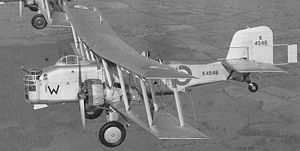Boulton & Paul Overstrand
| Boulton & Paul Overstrand | |
|---|---|

|
|
| Type: | bomber |
| Design country: | |
| Manufacturer: | |
| First flight: |
1933 |
| Commissioning: |
1934 |
| Number of pieces: |
24 (+5 conversions) |
The Boulton & Paul P. 75 Overstrand was a twin-engine medium bomber of the Royal Air Force that made its maiden flight in 1933. It was the last British biplane bomber and also the first bomber to have some kind of early autopilot. The machine was named after the town of Overstrand in northern Norfolk .
Construction and special features
The machine was a braced biplane whose three-part upper and four-part lower wings each had the same wingspan . The construction was carried out in mixed construction. The front part of the fuselage was built in a wooden shell construction, the middle section of the fuselage and the stern (except for the control surfaces of the structure), however, consisted of a fabric-covered frame made of duralumin . The load-bearing structures of the main wings and the elevator and rudder were made of more stable steel tubes, which were also covered with fabric. An auxiliary rudder was attached to the rudder, which improved the steering characteristics. All wings of the machine were equipped with ailerons . The landing gear , which was supported by struts towards the fuselage and the engines, could not be retracted, but had wheel brakes on all three tires; In addition, the tail wheel was steerable at the stern.
The bomber had a closed cockpit (in the previous model Boulton & Paul P.29 Sidestrand this was still open) and for the first time a swiveling armament in the nose of the fuselage. This was mechanically driven and also closed. The Boulton & Paul P.75 Overstrand was the first British bomber to receive such a gun post. For the first time on a British bomber, the cockpit and the arms were heated, which was an advantage for the crew, especially in cold seasons.
Working time
A total of only 24 machines were built from 1934, plus five Sidestrand III, which were rebuilt in Overstrand. The Overstrand came to the RAF No. 101 and No. 144 and various training units. As early as 1938, the machines were gradually taken out of active service and replaced by the Bristol Blenheim , which was completed by August 1938. In September 1938, the standard silver paint used until then was replaced by a camouflage paint in brown and green.
From autumn 1938, the machines were no longer used for first-line operations; when the war broke out in 1939, eleven Boulton Paul P.75 Overstrand were still in use. Individual copies were still used as target aircraft in training until 1941. However, one machine broke apart in the air in 1940, which subsequently led to restrictions in use. In 1941 the last copies were taken out of service and scrapped.
Technical specifications
- Span: 21.95 m
- Length: 14.05 m
- Height: 4.73 m
- Wing area: 91.04 m²
- Empty weight: 3600 kg
- Maximum take-off weight: 5450 kg
- Climbing rate: 3.8 m / s.
- Service ceiling: 6860 m
- Range (with maximum load): 1000 km
- Crew: 4 men
- Top speed: 246 km / h
- Landing speed: 87 km / h
- Engines: two radial engines Bristol Pegasus II M3 with 580 HP each
- Armament: three 7.7 mm Lewis machine guns in three arms
- Bomb load: 726 kilograms (max.)
literature
- Wilfried Copenhagen (Ed.): The great book of aircraft types . Berlin 1990, p. 209.
Web links
Individual evidence
- ↑ cf. Olaf Groehler : History of the Air War 1910 to 1980 , Military Publishing House of the German Democratic Republic, Berlin 1981, p. 181
- ^ Owen Thetford: Sidestrand and Overstrand- Part 3 , Airplane Monthly, January 1995, p. 35